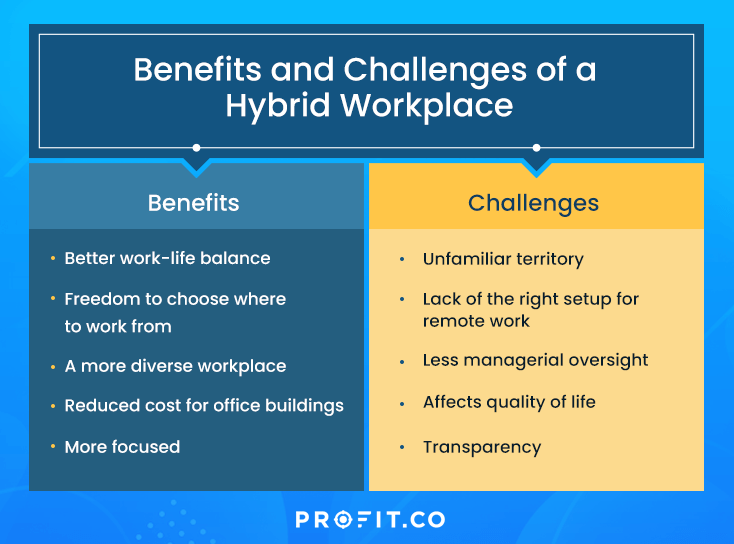What Is Hybrid Culture?
A hybrid culture is an environment that blends virtual and in-person work arrangements. It is a flexible working arrangement that has come about as a result of the past two years of the pandemic and is becoming increasingly popular. The hybrid employee experience has helped the workforce make informed choices in establishing a good work life balance. Employees in the hybrid culture can choose their place of work and their schedule.
What are the benefits and challenges of hybrid culture?
Hybrid culture comes with its own sets of benefits and challenges. Let’s take a look at what they are.
It is not the strongest of the species that survive, nor the most intelligent, but the one most responsive to change.
Benefits of hybrid culture
- Better work-life balance
- Freedom to choose where to work from
- A more diverse workplace
- Reduced cost for office buildings
- More focused
1. Better work-life balance
As hybrid culture eliminates the need to go to work on a daily basis, it is shown to be beneficial for work-life balance. Not having to commute to work, especially those who have long commutes, gives them more flexibility, which, in turn, leads to being happier at their jobs. And with happier jobs comes more satisfaction, improves productivity and retention.
2. Freedom to choose where to work from
The pandemic has proven to us that remote work indeed is possible. And that’s it’s also possible to be productive, maybe even more productive that being at work on-site. The freedom to choose where to work from is a huge benefit to not only employees, but for employers as well. With hybrid culture and remote work in practice, companies have the freedom to recruit talent from anywhere in the world, and individuals have the freedom to work with any company they want to without worrying about whether they are in the same geographical location as the company.
3. A more diverse workplace
The freedom to work from anywhere and to hire from anywhere in the world has widened the talent pool. And widening of the talent pool has paved the way for a more diverse workforce. Remote work and hybrid culture has made the workplace more welcoming to diversity, to parents, and people with disabilities.
4. Reduced cost for office buildings
If there are fancy office buildings, the organization would want its employees to come on-site for it to make sense for having an office building! But when everything is remote or hybrid, organizations, companies don’t have to spend as much on buildings. They don’t have to accommodate large numbers of people all at once in one office space. Instead of spending so much on buildings, they could rather spend on technology, including technology to make hybrid work more efficient, or employee wellness programs, or expanding to other markets.
5. More focused
When the need to commute to work is not there anymore, one tends to make up for the lost time immediately. It gives them more energy, less stress of commuting and way more focused and therefore, more productive. A hybrid work culture makes way for more trust in the employees, and in turn, results in better efficiency and business outcome. Want to get started on an intuitive and agile OKR software to enhance your employee engagement and employee development? Start your free trial of Profit.co!

Challenges of a hybrid workplace
We’ve looked at the benefits of a hybrid workplace. For every yin, there must be a yang, and so there must be challenges in a hybrid workplace too.
- Unfamiliar territory
- Lack of the right setup for remote work
- Less managerial oversight
- Affects quality of life
- Being transparent
1. Unfamiliar territory
All these changes, albeit quite a few, have happened only in the past two years. It’s still a fairly new concept that requires getting used to. It’s not easy to find a way to make it work all at once; it needs some trial and error.
2. Less managerial oversight
Less managerial oversight for a lot of companies could be a new concept to navigate. While this is under ‘challenges’, this might not necessarily be a bad thing always, for it means less micromanagement, more trust in the team members and entrust them with more responsibilities, and it increases the team’s sense of ownership.
3. Lack of the right setup for remote work
Not always, and everyone has the right setup to work remotely. That coupled with the situation when multiple people are working remotely; it can become difficult to focus. Employees working remotely have to compete for space and resources at home. In order to circumvent this situation, organizations can redirect the resources that they typically allocate to office space in order to provide the technology employees need to work effectively at home. Management can conduct an employee engagement survey to find the gaps in aligning the remote teams to the goals and objectives and try to eliminate them with it by suitable measures.
4. Affects quality of life
While hybrid work is more flexible, there is a downside to it. More flexibility can affect quality of life as the lines between work and personal life start to blur. People working remotely tend to work longer hours, on weekends, and have a tough time separating work hours from leisure time. Work hours often eat into leisure hours.
5. Being transparent
Transparency is of utmost importance in a hybrid work environment. Lay stress on the importance of open communication. Lack of transparency leads to biases within the organization. Lack of transparency can make the remote employee feel that they are at a disadvantage because they are not on-site. Using goal management tools like good OKR software can connect remote employees to the team and management to ensure effective communication. This can impact the morale of the remote employee tremendously. Transparent communication practices make sure remote and office-based employees remain equal.
In Conclusion
OKRs and the Hybrid work Model There are two things to bear in mind: Hybrid culture is here to stay, and no one size fits all. The secret to building a successful hybrid culture is knowing that employees’ needs come first. Listen to what hybrid employees are saying, and go from there to make a collaborative environment a success. When it benefits all employees, it will also benefit the entire organization as a whole.

